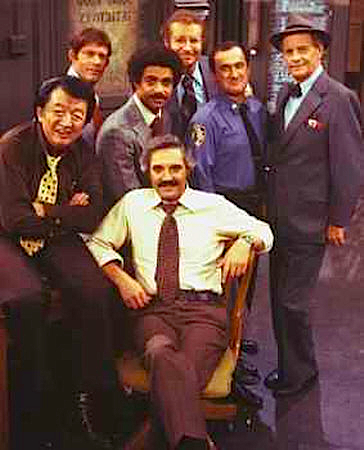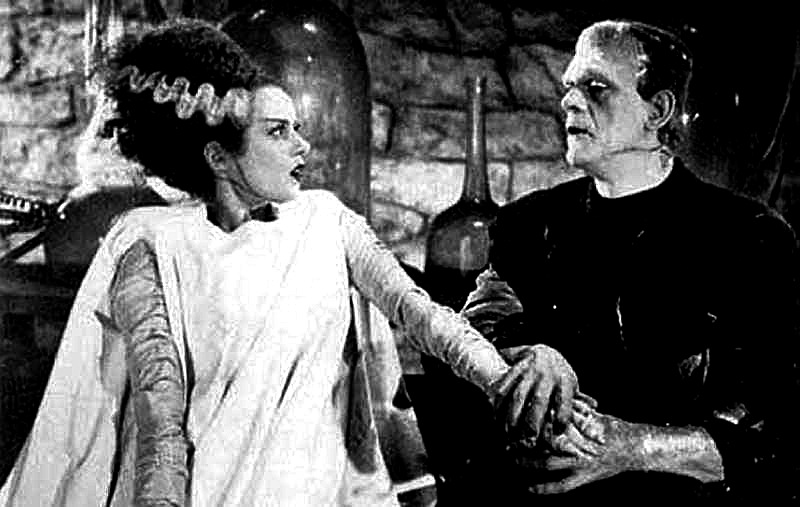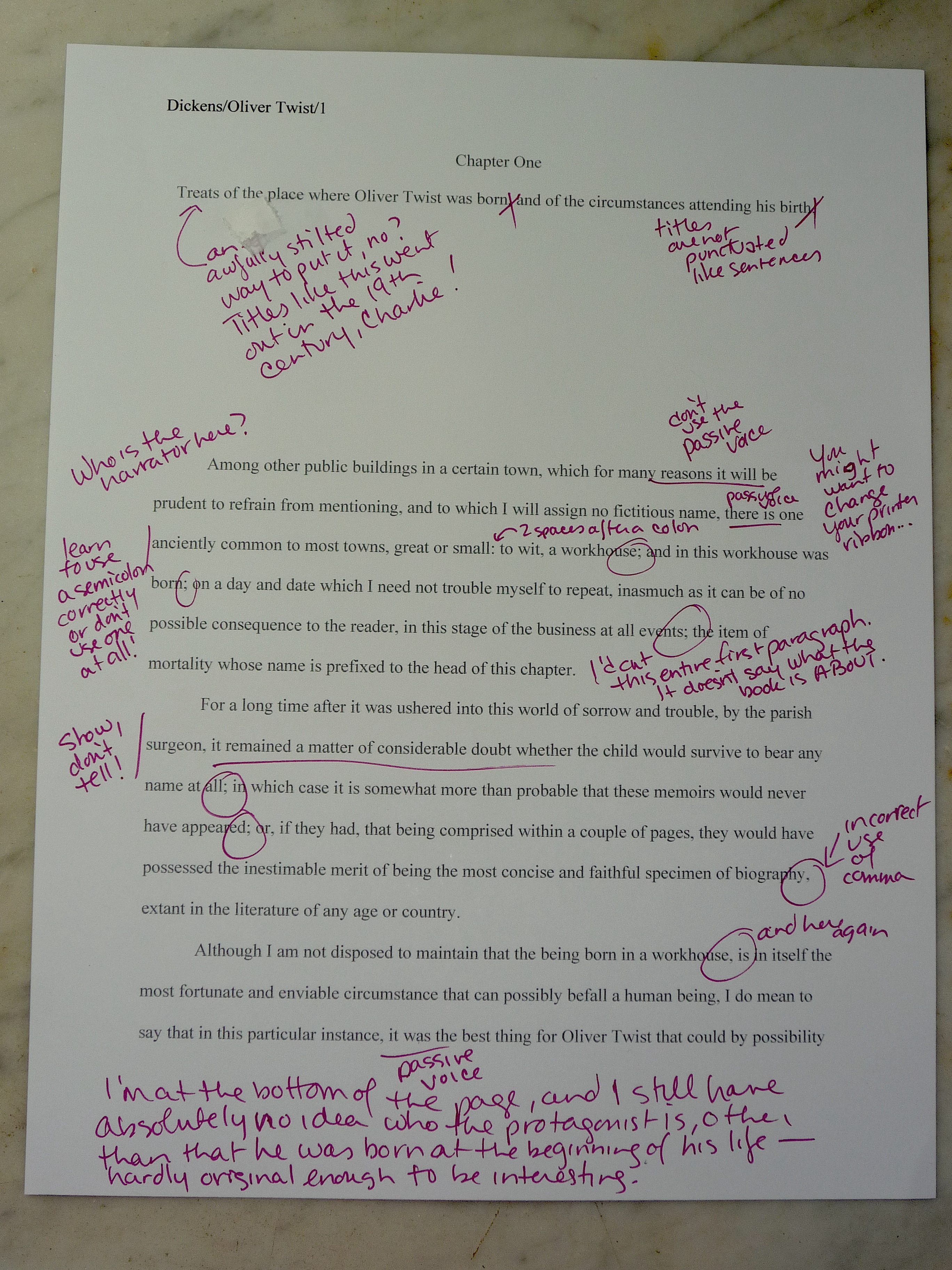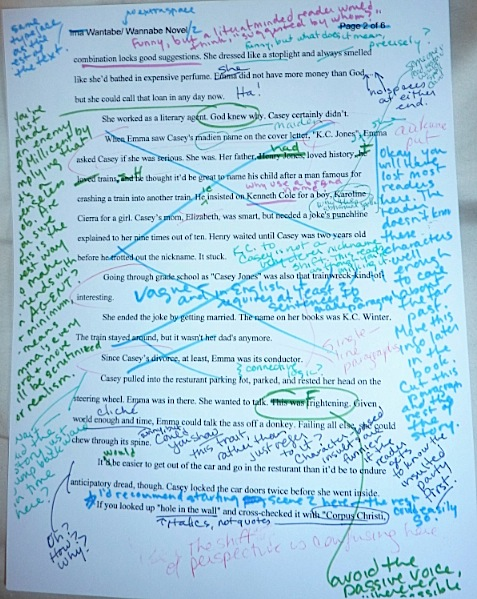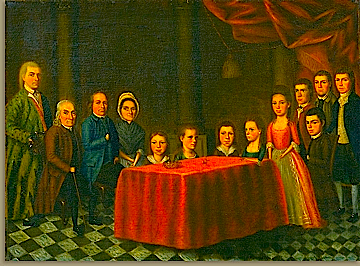It’s Christmas Day, campers, but my tree has gone dark: the electricity has been out for the last two hours. The local authorities claim that gigantic boom we all heard around noon resulted from a frantic windstorm’s having taken out a transformer. A less literary-minded analyst might take this story at face value. You can’t fool me, though. This is obviously Phase I of the Grinch’s most recent plan to steal Christmas.
Either that, or the Great Celestial Plotmaster(s) have been reading a lot of classic mystery lately. The day has all the hallmarks of the genre: while stoplight at the top of the hill’s being on the blink (or, rather, uncharacteristically not being on the blink) is admittedly the kind of thoughtfully-selected, pragmatic detail that makes a fictional world spring to life on the page, my brunch guests’ finding themselves plunged into darkness — or as close to darkness as a deep gray Seattle afternoon will permit — must hardly have come as a surprise to those familiar with the genre. I’ll bet you saw it coming the proverbial mile away. What’s next, a cat leaping out of nowhere to startle us at a suspenseful moment?
I mean, really: all of the characters are gathered in one place, and the lights go out? Even the Agatha Christie-impaired around the table immediately began making nervous jokes about which one of us was about to meet a grisly fate.
That’s why, in case any of you have been wondering since last spring’s foray into editorial pet peeves and how to avoid them, I tend to urge savvy revisers not only to scan their manuscripts for places where summary statements (such as All the lights went out could be productively replaced with character- or situation-revealing details (In the middle of the soup course, the chandelier suddenly gave up on emitting light. Even the stoplight at the corner had ceased blinking annoyingly in Montel’s peripheral vision. The butler fumbled in the sideboard for matches.), but for opportunities to surprise and delight the reader with unexpected specifics (In the middle of the soup course — a clear, sherry-laced leek broth with a jaunty dollop of crème fraîche floating gaily on top — the dusty chandelier suddenly gave up on its losing battle to shed light on the table. Even the stoplight at the corner had ceased blinking annoyingly in Montel’s peripheral vision. Startled, he knocked his shrimp fork onto a passing cat.).
My, but that was a long sentence. Somewhere in the literary stratosphere, the late Henry James must be chortling over his holiday goose, muttering to Edith Wharton, “They just don’t make ‘em like that anymore.”
“Too few semicolons for my taste,” Edith replies. “And watch your elbow: if you knock the figgy pudding over, you are sure to set the tablecloth on fire.”
My point, should any of you by some remote chance have lost sight of it in the midst of all that frenetic activity, is that while every type of book — and certainly every genre of fiction — has its own conventions, tropes, and characterization expectations, word for word, a writer is going to get substantially more expressive mileage out of a creative telling deal than one that any inveterate reader of that book category could guess. Or even, if it’s a common enough element, add subconsciously to the scene if it does not appear on the page.
Oh, when you read that second description of the lights going out, you didn’t murmur, “I bet the butler did it,” before your eyes passed the parenthesis at the end of the example?
Yes, Millicent the agency screener is encouraged — indeed, is often explicitly trained — to be on the look-out for manuscripts that read like, well, books in their chosen categories, and yes, each book category, particularly each genre fiction category, has its own recognized and recognizable plot twists, plot lines, stock characters, and, yes, types of details. Because agents specialize in particular types of book, as well as certain types of voices — a fact well worth bearing in mind when selecting which agents to query — it does tend to be to a writer’s advantage at submission time if the manuscript fulfills category-specific expectations. (That’s as true in a query’s descriptive paragraph as in a submission’s first few pages, by the way: if the text doesn’t sound as though it would fit comfortably within the manuscript’s chosen book category, it will usually be rejected.)
Let’s face it, though, the line between making your text read like it belongs shelved with others like it and like a cliché fest can sometimes be pretty thin. Many an aspiring writer believes, mistakenly, that producing a pale replica of a famous author’s writing is a better way to win friends and influence people at an agency than to come up with something more original. Or, even more mistakenly, does not become familiar enough with what’s currently being published in that book category to be aware what conventions would now strike someone who deals with those manuscripts for a living as passé.
To put it another way: when was the last time you read a mystery in which the butler actually did it?
The result, unfortunately, is that our poor Millicent tends to see the same types of specific — as well as the same plot twists, character types, and even phrasing — over and over and over again. When you consider the sheer volume of stories within the same category any agent successful in selling such books receives in any given year, that’s hardly astonishing.
The trouble is, most submitters remain woefully in the dark (and not because the lights went out) about how such elements are likely to be received at an agency. Good writing in a particular book category is good writing, right?
Sheer repetition has made Millicent believe otherwise, alas — but honestly, it’s hard to blame her for feeling that way. What might strike Writer A as requisite for that genre is frequently precisely what Writer B considers an homage to a classic and what Writer C will decide to drop in as a humorous riff on a cliché. And that’s not even counting what Writers D-F will honestly believe is original, but is actually a subconscious lifting of material or phrasing from an admired book.
“Oh, come on,” Millicent mutters, scalding her lip on that too-hot latte she forgot in her annoyance she had set aside to cool. “Does this writer honestly think that someone who reads as much as I do can possibly read an opening line like Yesterday, I fantasized that I returned to Ottawa without Daphne du Maurier’s REBECCA springing to mind? Last night I dreamt I went to Manderlay again is arguably the most famous first line in the genre!”
Wondering why I am bringing all of this up in the midst of a series on querying? Well, several reasons. First, I wasn’t going to post today at all, but as my guests went home when the soup got cold, I had a bit of extra time on my hands. I also had a charged-up laptop, as it happens, so clearly, this is kismet.
Especially as I had a holiday-themed anecdote I had been itching to recycle, anyway. I could have worked it into a series of queries, but hey, it’s a holiday — I thought everyone might enjoy a little break from our two solid months of query consideration. And correct me if I’m wrong, but I’m guessing that those of you devoted enough to your writing to be checking in at Author! Author! today might be more seriously interested in a discussion of craft than your garden-variety casual Internet browser.
Either that, or you might be trying to avoid your nearest and dearest. I’m happy to help you do that, too.
So gather close to the Yule log, campers, and let me spin my tale. As you read, try to think like Millicent: does the narrative contain enough specifics to provide all of the characterization needed? Does it occasionally stumble into the realm of cliché? While you’re at it, why not embrace the chance to embrace the Author! Author! tradition of trying to figure out what editorial tweaks could improve the story?
Curly the camel, Moe the donkey, and, to mix Christmas traditions as thoroughly as possible, Donner the reindeer have been on tour together, strip mall manger scene after strip mall manger scene, since they were just small, furry refugees from the petting zoo where they were born. Despite their years of entertainment experience, my local nursery — plants, not animals — plasters the six-foot wire fence around their enclosure with warnings to wreath-buying patrons about keeping their fingers, gloves, hat pom-poms, scarf tassels, and bundled-up infants away from Curly’s long reach, Moe’s strong teeth, and Donner’s oddly-shaped antlers.
They also, somewhat less emphatically, erect a sign informing dog-owners that crèche livestock are not, to put it mildly, best friends with man’s best friend. Since dogs cannot, unfortunately, read and many leash-tugging owners apparently do not, poor Curly frequently thrusts himself between some yapping visitor and his hoofed friends. Nearby, nursery personnel visibly restrain themselves from shouting, “Hey, can’t you read?”
On the whole, though, human behavior seemed to leave the trio unfazed. Scores of children flung hay at them, bellowing, “Hey, Reindeer!” — or “Hey, Dog,” from those who had never seen a miniature donkey before or were confused by the ambient barking. The trio just stood there, blinking slowly, eyes glazed. Most of the time, the parents would intervene before the children grew too frustrated with their passivity and rushed the pens.
One small pink-clad screamer simply would not leave the animals alone, however. She kicked at the metal fencing, screaming words I was a surprised a kindergartener would be able to use correctly in a sentence, or, indeed, incorporate into her everyday vocabulary without getting expelled. When she picked up a rock, I wandered over to the fence to distract her with a hastily-constructed fairy tale about our barnyard friends. And camels.
Almost immediately, a bulbous man in shorts and a t-shirt materialized by my side. Despite ambient cold that left our breath visible, his exposed arms and legs were not even goose-bumped. “Come over here,” he barked at the little girl, dragging her along the fence until they were directly in front of Curly.
Was he going to make her apologize to the camel? Curly did not seem to be expecting it, but perhaps his furry friends would appreciate the gesture.
Releasing the quivering child, the man — whose clothing, I noticed, was emblazoned with advertisements for a local band and Nike, respectively, not the nursery — reached up and over the chain-link fence, snapping his fingers. Placidly, Curly dipped his head, extending his hyper-mobile lips toward the hand.
Curious to hear what happened next, aren’t you? That’s a good indicator that a scene is paced well. See how selecting those details carefully, as well as not over-burdening the text with explanations, can increase suspense while simultaneously moving the plot along?
So why, I ask you, would our old pal Millicent, have stopped reading part-way through paragraph #3? Because, I assure you, most would have: one of her most notorious pet peeves has reared its ugly head here.
If you pointed out that the narration switched tenses between the second and third paragraphs, congratulations! Paragraphs Nos. 1 and 2 are in the present tense; paragraph #3 is in the past.
Submissions and contest entries do that all the time; so do, believe it or not, descriptive paragraphs in query letters. Sometimes, they even switch back to the original tense later in the text, or vacillate from sentence to sentence.
Already, I can spot some raised hands out there. “But Anne,” adherents of variable tenses point out, and with some reason, “Paragraphs #1 and #2 describe ongoing conditions, while paragraph #3 on focuses upon one-time events. Doesn’t that mean that the tense choices here are appropriate, or at least defensible?”
Good question, lovers of the present tense. Professional readers — agents, editors, contest judges, writing teachers, etc. — are trained to spot redundancies in a manuscript. They’re also taught to leap upon inconsistencies.
In other words, Millicent is likely to assume that the change of tense is not the result of well thought-out authorial choice, but simply a mistake that did not get caught in the proofreading process — or, if this were a descriptive paragraph in a query, the after-effects of an incomplete merger of two different versions, one in the present tense and one in the past.
Why might that make her stop reading altogether? Like other commonly-made errors, the tense inconsistency may well jar her out of the flow of the story. Next!
You habitual tense-switchers are not particularly happy with that answer, are you? “Okay, so she’s detail-oriented, but this isn’t a writing mistake; this is a stylistic choice. So why would Millicent be annoyed by it?”
On its face, your logic is pretty sound, tense-switchers: it would indeed be possible, within the context of a civil conversation between author and reader, to justify the tense choices in the example above. A writer might ostensibly win an argument with, say, a writing teacher, critique group, or even an editor about keeping the switch in the text. But that doesn’t mean it would be a good idea to submit pages with tense inconsistencies to Millicent — or to her aunt Mehitabel the contest judge, for that matter.
Why, you ask? Long-time readers of this blog, chant it with me now: because the writer is seldom present when an agency screener, editorial assistant, or contest judge encounters his manuscript for the first time. Successful manuscripts, queries, synopses, and contest entries are thus those that do not require additional verbal explanation.
So even if the writer is technically correct, if a tense switch seems unjustified to Millicent — if it appears to be, say, an incomplete revision between a manuscript originally in the present tense and a subsequent draft in the past, or vice-versa — that’s usually the ball game. So why risk it? Especially when, as in this case, making the tense consistent does not detract at all from either the meaning or the voice of the section. Lookee:
Curly the camel, Moe the donkey, and, to mix Christmas traditions as thoroughly as possible, Donner the reindeer had been on tour together, strip mall manger scene after strip mall manger scene, since they were just small, furry refugees from the petting zoo where they were born. Despite their years of entertainment experience, my local nursery — plants, not animals — plastered the six-foot wire fence around their enclosure with warnings to wreath-buying patrons about keeping their fingers, gloves, hat pom-poms, scarf tassels, and bundled-up infants away from Curly’s long reach, Moe’s strong teeth, and Donner’s oddly-shaped antlers.
They also, somewhat less emphatically, erected a sign informing dog-owners that crèche livestock are not, to put it mildly, best friends with man’s best friend. Since dogs cannot, unfortunately, read and many leash-tugging owners apparently would not, poor Curly frequently thrust himself between some yapping visitor and his hoofed friends. Nearby, nursery personnel visibly restrained themselves from shouting, “Hey, can’t you read?”
On the whole, though, human behavior seemed to leave the trio unfazed. Scores of children flung hay at them, bellowing, “Hey, Reindeer!” — or “Hey, Dog,” from those who had never seen a miniature donkey before or were confused by the ambient barking. The trio just stood there, blinking slowly, eyes glazed. Most of the time, the parents would intervene before the children grew too frustrated with their passivity and rushed the pens.
That’s as painless a revision as you’re ever likely to encounter, folks, by see how big a difference it makes to the text? All it requires is a good proofreading eye and a willingness to view the story from Millicent’s perspective, not the writer’s. (The latter, after all, is already familiar with the storyline.) And need I even add that this variety of inconsistency is easiest to catch if one reads one’s submission or contest entry IN HARD COPY, IN ITS ENTIRETY, and OUT LOUD?
I thought not. Let’s move on with the story, to see if we can catch any other Millicent-displeasers.
Delicately, politely, as if he were extracting an egg from beneath a mother hen, Curly took the man’s fingers into his gargantuan mouth. The hand did not budge. The camel paused meditatively for a few seconds, tasting, then sucked the hand into his mouth up to the elbow, dragging the man up to his tiptoes.
Instinctively, I took a step toward the child. If the object lesson about the dangers of violating animals’ personal space was about to go horribly awry, the least I could do was shield her from seeing the bloody denouement.
The man waved me back with his free hand. “See, Tanya?” he told the saucer-eyed girl. “They like people. If you treat them nicely, they’ll treat you nicely.”
“That’s right, sweetie,” a stringy-haired woman called from the nearby wreath display. “Be nice to the animals, and they’ll never hurt you.”
“You just have to learn what they like.” A helpful bystander kicked a tall crate toward the man’s feet, so he could follow his arm skyward. “Camels love sucking on things.”
Mentally, I began taking notes, in preparation for my inevitable testimony in a court of law. “I think she’s got the point. Maybe it’s time to back off now?”
Okay, what’s the problem this time? Hint: it’s even harder to catch than the last.
No? What about all of that redundancy in the dialogue?
That made some of you do a double-take, didn’t it? “But Anne,” several exclaim, “that’s how people talk in real life! You’re not gearing up to tell us that Millicent finds realistic dialogue annoying, are you?”
Um, sort of. At least the parts of real-life speech that are redundant. Or not germane to what’s going on. Or just plain boring.
Which is to say, as any close listener to everyday speech would happily tell you, most of it.
Oh, how often writers forget that real-life dialogue generally does not reproduce well on the page! If I had a nickel for every time I’ve heard a writer say, “But s/he really said that!” or “But that’s what people really sound like!” I would buy my own Caribbean island and send my entire readers on free writing retreats.
“But Anne,” I hear some of you protest, “isn’t that pretty self-evident? Just as absolutely faithful recreations of real-life events often don’t translate well into fiction, neither does most dialogue. Am I missing an additional nuance here?”
Perhaps one: aspiring writers are also apt to forget that real-life dialogue is seldom character-revealing — and thus reproducing it in a manuscript will often not convey as much about a character as we sometimes expect. Take, for instance, the oh-so-common writerly habit of placing the speeches of an annoying co-worker, relative, ex-lover, nasty dental receptionist, etc. into fictional mouth of a minor novel character as a passive-aggressive form of revenge.
Come on, every writer’s at least thought about it. To a professional reader, the very plausibility of this type dialogue often labels it as lifted from real life:
“Oh, wait a minute, Sarah.” Pausing in mid-gossip, Theresa picked up the overturned plastic cup before anyone else could step on it, placing it neatly on the dining hall checker’s desk.
Dina the checker glared at it as if it was covered in baboon’s spit. “Don’t you dare leave your trash on my desk. Do you think I have nothing to do but clean up your messes?”
“It was on the floor,” Theresa stammered awkwardly.
“Don’t you give me your excuses.” Dina grew large in her seat, like a bullfrog about to emit a great big ribbet. “You walk that right over to the trash can. Now, missy.”
“I thought you had dropped it.”
“Go!”
“I’ll save you a seat,” Sarah offered, embarrassed.
Inwardly seething and repenting of her Good Samaritanism, Theresa obediently gave up her place in the block-long lunch line in order to take the walk of shame to the garbage receptacles on the far end of the dining hall. How quickly a good mood could evaporate!
Tell me: what about this scene would tip off Millicent that this really happened, and that Dina is a character, if not from Christmas Past, at least ripped from the writer’s actual experience? And why would her being able to tell this be a liability? Why, in fact, would Millicent be surprised if Dina never showed later in the book any side other than the touchy one displayed here — or, indeed, if she never appeared again?
Actually, that was a set of trick questions. The answer to each part is the same: because the narrative doesn’t provide enough motivation for the intensity of Dina’s response. Fairly clearly, the writer doesn’t think that any such explanation is necessary.
That’s usually an indication that the writer has a fully-formed mental image (negative, in this case) of the villain in question — something that Millicent, by definition, would not walk into the scene possessing. Nor would any other reader who was neither there when the incident occurred nor had heard the author complain vociferously about it.
In other words, what we have here is a rather subtle manifestation of the telling, rather than showing phenomenon. Because the writer experienced this exchange as nasty because Dina was nasty, she has assumed that the reader will perceive it that way as well. But without more character development for Dina — or indeed, some indication of whether this kind of insistence was typical for her — the reader isn’t really getting enough information to draw that conclusion.
Or any other, for that matter. It’s just an anecdote. Yet most self-editing writers, especially those who happen to be writing memoir, wouldn’t notice this narrative lack. Any guesses why?
If you immediately shouted that it was due to the fact that his memory of Dina the real person is so strong, help yourself to four peppermint cookies from the holiday table. In the writer’s mind, her character is so well established that he can just write about her, rather than helping the reader get to know her.
The other tip-off that this was a real exchange is that Theresa is presented as a completely innocent victim of an unprovoked attack. The pure villain vs. completely blameless protagonist is a dead giveaway that dear self is concerned.
And yes, I WAS darned annoyed when Dina — in real life, a very nice woman named Ellen who happened to be having a spectacularly bad day — misinterpreted my act of good citizenship. If I crave well-deserved vindication from the total strangers who might conceivably read this story, however, it’s incumbent upon me to do quite a bit more character development. Not to mention integrating the incident into the storyline well enough that it’s actually interesting to read.
Of course, we want to be true-to-life in our dialogue: as Virginia Woolf tells us, “fiction must stick to the facts, and the truer the facts, the better the fiction.” But let’s not forget that in order to maintain a reader’s interest, a book has to have entertainment value, too — and that however amusing a verbal tic might be in person, repetition is often annoying in on the page.
This is especially true when a character is tired, angry, or in pain, I notice: all of a sudden, the dialogue sounds as though all of the characters are trapped in one of those interminable Samuel Beckett plays where the people are doomed to move immense piles of sand from one end of the stage to the other with teaspoons. See if this dialogue sounds familiar, theatre-goers:
A: “Oh. You’re home.”
B: (nursing the thumb the elephant trod upon in the last scene) “Yeah.”
A: “Have a nice day?”
B: “Um-hm.”
A: “I was cleaning out the attic today, and I came across that picnic blanket we used when we went out to Goat’s Rock Beach to scatter Father’s ashes. How it rained that day, and then the sun broke out as if Father and God had joined forces to drag the clouds aside to smile upon our picnic.”
B: “Yeah. “
A: “Ham sound good for dinner?”
B: “Yeah.”
A good third of the dialogue Millicent sees runs approximately like this, I tremble to report. Understand now why she might become just a tad touchy at the sight of dialogue that provides neither character development nor moves the plot along?
As a general rule of thumb — sore or otherwise — I like to flag any piece of dialogue that contains more than one use of yeah, really, yes, no, uh-huh, or, often, um. Almost invariably, these are an indication that the dialogue could either be tightened considerably or needs to be pepped up.
Similarly, anyway and however in dialogue are pretty reliable flares, indicating that the speaker has gotten off-topic and is trying to regain his point — thus warning the manuscript reviser that perhaps this dialogue could be tightened so that it stays ON point.
My fictional characters tend to be chatty (dialogue is action, right?), and I was once taken to task for it by a fairly well-known author of short stories. She had just managed to crank out her first novella — 48 pages typeset, so possibly 70 in standard manuscript format — so perhaps unsurprisingly, she found my style a trifle generous with words.
“Only show the dialogue that is absolutely necessary,” she advised me, “and is character-revealing.”
Hard to argue with that, eh? Yet, like most writers receiving critical feedback, I fought it at first. Since the dialogue in my advisor’s published works has seldom, if ever, strayed beyond three lines, regardless of situation or character, I was not particularly inclined to heed this advice — have you noticed how often it’s true that established writers with little or no teaching background spout aphorisms that all boil down to write as I do? — but I have to say, it has been useful in editing, both for others’ work and my own.
I can even derive an axiom of my own from it: if a person said it in real life, think twice before including it. If it isn’t either inherently interesting, plot-advancing, or character-revealing, does it really need to be there?
One more insight, then I’ll let you get back to your relatives: you’ve been having just a little trouble paying attention to my arguments, haven’t you? I’m betting that some substantial part of your mind has been distracted, wondering what happened to the arm in the camel’s mouth.
That, my friends, is how Millicent — and most other readers, professional and non-pro alike — feels when an interesting one- or two-paragraph teaser, the kind that aspiring writers so love placing within italics at the beginning of their manuscripts, gives way to an apparently or only tangentially unrelated second scene. Yes, we see it in published books all the time, but in a submission, it’s a risky strategy.
“Hey!” Millicent cries, spitting out her mouthful of scalding latte, “what happened to that darn interesting plot I’d gotten absorbed in? What’s this writer trying to do, hook me with something exciting, then drop me into a comparatively mundane storyline?”
Let’s be honest, folks: that’s precisely what most writers who use this trick are trying to do. Professional readers are wise to it by now.
Remember, part of being a good storyteller involves knowing when to relieve the suspense — and frankly, in the case of my camel story, Alfred Hitchcock himself would have chosen to do so by now. Ahem:
“Give me a boost,” the man asked calmly, but his eyes were beaming panic over his daughter’s head. Curly’s lips were exploring the first few inches of his t-shirt sleeve.
Since his arm appeared to be on the verge of being ripped off at the shoulder, the crate-kicker and I hastily complied. With his uneaten hand, he began tickling the camel’s lips, rubbing the gums as if he were a mammalian dentist. Curly face elongated, as though he were going to sneeze. A loud pop, a slurp, and the man’s arm returned to the land of the living.
He strutted his way down from the crate. “See?” he told the girl. “If you know what you’re doing, they won’t hurt you.”
“Yes, Daddy,” she whispered, staring aghast at his friction-reddened arm, manifestly resolving never to have anything whatsoever to do with an animal larger than herself again.
The moral, if I may venture one: just because something seems like a good idea at first blush doesn’t mean that it’s worth stubbornly adhering to it. One of the keys to successful self-editing is flexibility.
That, and keeping any parts of your body involved in typing out of animals’ mouths. Happy holidays, everybody, and keep up the good work!

